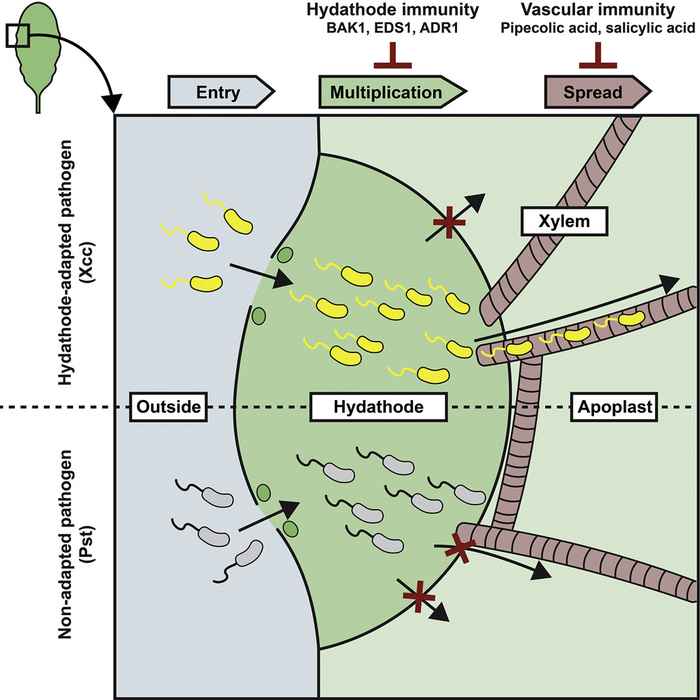Water pores in leaves proven to be part of plant's defence system against pathogens
2 February 2023

Anyone who is used to giving plants plenty of water might know the phenomenon: small droplets of plant sap that sometimes appear at the edge of the leaves. Especially at night times. When plants take up more water via their roots than they lose through evaporation, they can use their water pores on the leaf margins to release excess water. The pores literally prevent root water pressure from becoming too high. An important mechanism – but at the same time, risky. Pathogenic microorganisms can enter the plant's veins through these sap droplets to colonize the water pores.
Biologists have therefore been asking themselves for a long time: how do plants defend themselves against this wide-open entry point? Are those water pores—the scientific name is hydathodes— defenceless glands that allow ample entry of harmful pests? Or have they evolved in such a way that they are part of the plant's line of defence against pathogens?
Arabidopsis experiments
A team of researchers from the Swammerdam Institute for Life Sciences at the University of Amsterdam has found evidence that the latter is the case. In the journal Current Biology they describe their experiments with the model plant Arabidopsis and two types of harmful bacteria. Arabidopsis, or thale cress, is related to all types of cabbage and other edible plants in the Brassicaceae family. The biologists discovered that the water pores are part of both the plant's first and second line of defence against bacteria. In other words, they are involved in both the rapid initial response and the follow-up actions against the invaders.
Harrold van den Burg, who led the team of researchers, explains: ‘For this study, we used Arabidopsis mutants with deficits in their immune system that made them more susceptible to infection with the bacteria Xanthomonas campestris and Pseudomonas syringae. We selected these bacteria because they cause notorious problems in agriculture. Here they were used to help unravel the plant immune system. We were able to establish that two protein complexes (for those interested: BAK1 and EDS1-PAD4-ADR1) prevent the bacteria from multiplying in the water pores. The same immune responses also prevent these bacteria from advancing further into the plant interior. In addition, we discovered that when this first line of defence occurs, the water pores produce a signal that causes the plant to produce hormones that suppress further spread of the invading bacteria along the vascular system.'
Crop protection
The team thus provides an important fundamental insight into how these natural entry points for bacteria have evolved and are protected by the plant's immune system. In the long term, this may help to make agricultural crops more resistant to bacterial diseases. Van den Burg: ‘For now we will continue with this line of research. For example, we now know which protein complexes are involved in preventing bacteria from multiplying in the water pores, but not how this happens. Do they for instance regulate the production of antimicrobial substances in hydathodes that inhibit bacterial growth? That would be interesting to know. The better we understand this, the closer we get to a practical application for better protection of agricultural crops.'
Details of the publication:
Misha Paauw, Marieke van Hulten, Sayantani Chatterjee, Jeroen A. Berg, Nanne W. Taks, Marcel Giesbers, Manon M. S. Richard, and Harrold A. van den Burg: Hydathode immunity protects the Arabidopsis leaf vasculature against colonization by bacterial pathogens, in: Current Biology, 1 February 2023, doi: https://doi.org/10.1016/j.cub.2023.01.013